Today’s Current Affairs: 8th November 2024 for UPSC IAS exams, State PSC exams, SSC CGL, State SSC, RRB, Railways, Banking Exam & IBPS, etc
Table of Contents
Okinawicius tekdi : New Species Of Jumping Spider
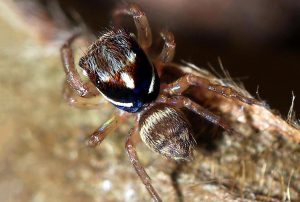
Researchers have found a new species of jumping spider on Baner Hill, yet again highlighting the region’s rich biodiversity and the need to protect the city’s natural landscapes.
- The spider has been named Okinawicius tekdi, after the Marathi word for hill, and takes the number of jumping spiders in India to 326.
- The species was first described by Atharva Kulkarni, an MSc student in environmental science from MIT-World Peace University in Pune.
- A spider species was last discovered in Pune over 30 years ago.
Al-Natah : Ancient Town Uncovered By Archaeologists
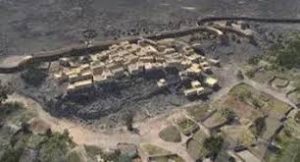
Archaeologists have uncovered a 4,000-year-old fortified town in Saudi Arabia, illustrating the gradual shift from nomadic to urban lifestyles.
- French archaeologist Guillaume Charloux and his crew led the discovery.
- Excavation at the Khaybar oasis has found that a sophisticated Bronze Age town existed between 2400 and 1500 BCE.
- The town reveals- The presence of an organised settlement in an era previously believed to be dominated by nomadic pastoral societies.
- It is enclosed by a 14.5-kilometre wall and occupies a 2.6-hectare area.
- It housed up to 500 residents who lived in multi-story dwellings.
- The town was likely a centre for agricultural production and trade, sustaining a cooperative society in the otherwise arid environment.
- Residents of Al-Natah lived in rectangular dwellings, constructed from materials such as stone and mudbrick, with narrow paths connecting the various structures.
- The town’s layout included burial sites, with some graves and tiered towers marking higher social status.
- A similar town in southern Saudi Arabia, Al Faw, was given UNESCO World Heritage Site status this year.
Spinal Muscular Atrophy:
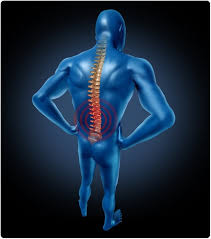
A 16-month-old child with spinal muscular atrophy (SMA) was chosen for gene therapy and was administered the drug at a private hospital.
- Spinal muscular atrophy (SMA) is a genetic disease affecting the central nervous system, peripheral nervous system and voluntary muscle movement (skeletal muscle).
- It involves the loss of nerve cells called motor neurons in the spinal cord and is classified as a motor neuron disease.
- There are five subtypes of SMA- type 0, 1, 2, 3, 4. Healthcare providers classify them based on the age of onset, as well as the severity and life expectancy.
- Spinal muscle atrophy symptoms vary and may be mild or disabling, but involve a weakness of the muscles that control movement. Involuntary muscles are not affected, such as those in the heart, blood vessels and digestive tract.
- The weakness in SMA tends to be more severe in the muscles that are close to the center of your body than in the muscles farther away from your body’s center.
- Treatment: There isn’t a cure for SMA. Treatment for SMA mainly seeks to manage symptoms and prevent complications. Symptom management therapies may include:
- Physical therapy, which can help improve posture, prevent joint immobility and slow muscle weakness.
- Occupational therapy, which can improve your ability to perform daily tasks.
- Assistive devices, like orthopaedic braces, crutches, walkers and wheelchairs.
- Therapy for speech and swallowing difficulties.
- A feeding tube if swallowing is too difficult and/or dangerous.
- Assisted ventilation for breathing issues.
- Medications for SMA: Between 2016 and 2020, the U.S. Food and Drug Administration (FDA) approved treatments that can significantly improve the course of SMA.
Bidar Fort : Waqf Board Identified As Its Property
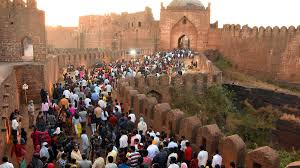
The Waqf Board identified 17 monuments inside the historic Bidar Fort in Karnataka as its property.
- Bidar Fort is situated in Bidar City on the northern plateau of Karnataka, India.
- The history of Bidar Fort dates back over 500 years, starting with the reign of the Western Chalukya dynasty.
- Sultan Ahmed Shah Wali of the Bahmani dynasty made Bidar his capital in 1430 and renovated it as an impressive citadel.
- It had been built of trap rock. Stone and mortar were used to build the fort walls.
- The entrance gate has a lofty dome, the interior of which had been painted in bright colours.
- Bidar Fort includes:
- Islamic and Persian architecture,
- Seven main entrances,
- 37 bastions (Balcony structures extending from the fort) of octagonal shape with metal-shielded cannons,
- Mosques and mahals,
- Thirty-plus Islamic monuments.
- The Bahmani Kingdom rose to power after the Turkish Governor Ala-ud-din Hassan Bahman Shan established an independent empire by revolting against the Sultan of Delhi Sultanate, Muhammad Bin Tughlaq in 1347.
MAHASAGAR Initiative:

The third edition of the high-level virtual interaction MAHASAGAR was conducted by the Indian Navy.
- Maritime Heads for Active Security and Growth for All in the Region (MAHASAGAR) — which means vast ocean in Hindi, is the Indian Navy’s flagship outreach for high-level virtual interaction among the leaders.
- The initiative, started by the Indian Navy, is conducted bi-annually and has garnered wide acceptance among the participating nations ever since its inception in 2023.
- Participating countries: Indian Ocean Region littorals viz., Bangladesh, Comoros, Kenya, Madagascar, Maldives, Mauritius, Mozambique, Seychelles, Sri Lanka and Tanzania.
- The interaction’s theme of this edition was ‘Training Cooperation to Mitigate Common Maritime Security Challenges in IOR’, which highlights the present and necessary imperatives for Training Corporation towards mitigation of common maritime challenges in the Indian Ocean Region.
- During the current edition, the principals candidly dwelled on the imperatives of quality training and opportunities for training collaboration between IOR littorals towards developing requisite capacities and skilled manpower to tackle Common Maritime Security Challenges in the IOR.
First Advance Estimates for Kharif crop production for the year 2024-25:
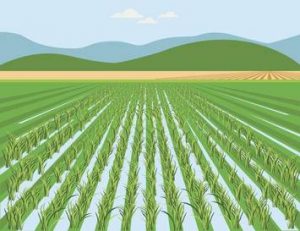
The Ministry of Agriculture and Farmers’ Welfare has recently announced the First Advance Estimates for Kharif crop production for the year 2024-25, revealing a record-breaking output in foodgrains and oilseeds.
- The report reflects the government’s growing use of technology and stakeholder input in agricultural planning and underscores a significant rise in production, especially in staple crops such as rice and maize.
- Key Highlights of the First Advance Estimates for Kharif Crop Production:
- Digital Crop Survey (DCS): For the first time, the DCS under the Digital Agriculture Mission (DAM) was used to estimate crop areas, replacing the manual Girdawari method in four states (Uttar Pradesh, Madhya Pradesh, Gujarat, and Odisha).
- Record Foodgrain Production: The total Kharif food grain production for 2024-25 is projected at 1647.05 Lakh Metric Tonnes (LMT), which is higher by 89.37 LMT as compared to 2023-24 and 124.59 LMT higher than average kharif foodgrain production, due to good production of Rice, Jowar and Maize.
World Cities Report 2024:

The UN-Habitat has released the World Cities Report 2024: Cities and Climate Action.
- The report highlighted that the cities are among the largest contributors to greenhouse gas emissions, yet they face disproportionately severe impacts of climate change.
Key Findings of the World Cities Report 2024:
- Temperature Increases: By 2040, nearly two billion people in urban areas will experience a 0.5°C rise in temperature.
14% of cities are expected to transition to drier climates while at least 900 cities could transition to more humid climates, especially tropical ones. - Sea-Level Rise: By 2040, over 2,000 cities in low coastal areas, many under 5 metres above sea level, will expose more than 1.4 billion people to higher risks from sea-level rise and storm surges.
- Disproportionate Impact: Urban areas are disproportionately affected by climate change but are also significant contributors to greenhouse gas emissions (GHGs) making them more vulnerable to climate shocks like floods and cyclones.
- Investment Gap: To build climate-resilient systems, cities need an estimated USD 4.5 to USD 5.4 trillion per year. However, current financing stands at just USD 831 billion, highlighting a massive funding shortfall.
- Riverine Flooding: Flood exposure in cities has grown significantly, increasing 3.5 times faster than in rural areas since 1975.
- By 2030, 517 million people in cities will be exposed to riverine flooding, representing 14% of the global urban population.
- Decline of Green Spaces: Urban green spaces have significantly declined from 19.5% in 1990 to 13.9% in 2020 contributing to both environmental and social challenges in cities.
- Increased Vulnerability: Informal settlements (slums) are key drivers of vulnerability, as they are often located in flood-prone, low-lying, or precarious areas.
- Lack of protective infrastructure, and legal recognition make them more exposed to climate impacts and unable to invest in upgrades due to eviction fears.
- Green Gentrification: Some climate interventions, like the creation of parks, have resulted in green gentrification leading to displacement of underprivileged communities.
- Gentrification means a low-income neighborhood changes due to an influx of wealthier residents and businesses, leading to rising property values and rents.
UN-Habitat :
- Established by the UN General Assembly, UN-Habitat focuses on promoting socially and environmentally sustainable urban development.
Tuna Cluster:
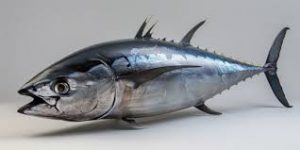
The Department of Fisheries, under the Ministry of Fisheries, Animal Husbandry, and Dairying, has designated the Andaman and Nicobar Islands as a Tuna Cluster under the Pradhan Mantri Matsya Sampada Yojana (PMMSY).
- With approximately 6.0 lakh square km of under-utilized Exclusive Economic Zone (EEZ) rich in tuna resources, the region offers unique advantages in fisheries development due to its proximity to Southeast Asia, sustainable fishing practices, and conducive trade routes.
- Tuna Fish Belongs to the Thunnus genus, adapted for speed with streamlined bodies.
- Found in both tropical and temperate oceans, known for extensive migrations.
- Tuna species like Skipjack, Yellowfin, and Bluefin contribute around $41 billion annually in trade (2018).
- Maintains a body temperature higher than surrounding water, a trait shared with Mackerel sharks and Opah.
- High in Vitamin B12, Vitamin D, Omega-3 fatty acids, proteins, and antioxidants, supporting health and nutrition.
Agrivoltaic farming:
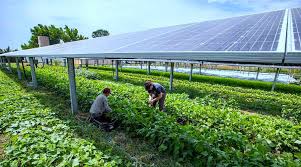
The Seventh Session of the International Solar Alliance (ISA) concluded in New Delhi, highlighting sustainable energy and agrivoltaic farming a practice that combines agriculture with solar energy generation on the same land.
- Agrivoltaic farming is the simultaneous use of land for agriculture and solar energy generation, allowing crops to grow beneath solar panels.
- Solar panels are raised 2-3 meters, providing space for crops to grow beneath with adequate light and air.
- Panels are angled and spaced to optimize sunlight for both solar energy and crop growth.
- Panels offer shade, reducing heat stress and protecting crops from harsh weather.
- Shading lowers evaporation, conserving soil moisture and reducing water needs.
- Panels on greenhouse roofs allow light/rain for crops while generating energy.
- Utilizes land for both solar power and agriculture, maximizing energy and food production.
- Agrivoltaic Farming:
- Maximizes land efficiency by combining agriculture and solar energy production on the same land.
- Provides shade to crops, reducing heat stress and water loss, and protecting from extreme weather.
- Contributes to solar power expansion, supporting climate goals and energy needs.
- Supports sustainable food production for a growing population without needing additional land.
- Enables farmers to diversify income through both crop production and solar energy revenue.
Millimeter Wave Transceiver:
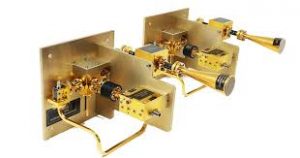
The Centre for Development of Telematics (C-DOT) has signed an agreement with the IIT Roorkee to develop a Millimeter Wave Transceiver aimed at improving 5G connectivity in rural areas under the Telecom Technology Development Fund (TTDF) scheme.
- Millimeter Wave Transceiver Technology is a device used to transmit and receive signals in the millimeter wave (mmWave) frequency range (30-300 GHz), enabling high-speed wireless communication for applications like 5G.
- It Uses small cells to emit high-frequency mmWaves that provide fast data rates over short distances; small cells are placed in clusters to ensure continuous coverage.
- Advantages – High data rates and bandwidth
- – Low latency
- – Less interference with other systems
- – Compact antennas for IoT compatibility
- – Increased data capacity
- Disadvantages
- – Limited range; blocked by physical objects
- – Prone to signal degradation from rain, humidity, and obstructions
- – Higher manufacturing costs and need for clustered cells
3rd edition of the World Solar Report series:
The 3rd edition of the World Solar Report series was launched at the 7th Assembly of the International Solar Alliance, spotlighting key areas in the global transition to sustainable energy. This year’s release includes four reports: the World Solar Market Report, World Investment Report, World Technology Report, and Green Hydrogen Readiness Assessment for African Countries.
Global collaborative platform for financial institutions and FinTechs : SBI
State Bank of India (SBI), in partnership with APIX—a global collaborative platform for financial institutions and FinTechs—has launched the ‘SBI Innovation Hub’ at the Singapore Fintech Festival from November 6-8, 2024. The hub provides a dedicated space for global FinTechs, startups, and innovators to create next-generation financial solutions that meet the digital needs of SBI’s diverse customer base.
QS Asia Rankings 2025:
The QS Asia Rankings 2025 recently unveiled by Quacquarelli Symonds (QS) reflect India’s significant academic progress on a global scale. With 161 Indian universities included among the 984 ranked institutions across Asia, and six institutions making it to the top 100, this ranking affirms India’s expanding influence in the academic landscape of Asia.
Reserve Bank of India (RBI) has expanded the list of Government securities available for non-resident investment under the Fully Accessible Route:
The Reserve Bank of India (RBI) has expanded the list of Government securities available for non-resident investment under the Fully Accessible Route (FAR) by designating 10-year Sovereign Green Bonds (SGrBs) as ‘specified securities.’ These bonds will be issued by the government in the second half of the fiscal year 2024-25, aligning with the increasing global inclusion of Indian Government Securities
Arjun Erigaisi made a significant leap in the chess world by securing the world No. 2 spot in live ratings:
Arjun Erigaisi made a significant leap in the chess world by securing the world No. 2 spot in live ratings on 7th November. His victory over Alexey Sarana in Round 3 of the Chennai Grand Masters tournament boosted his live rating to 2805.8, propelling him past both USA’s Fabiano Caruana.
ZIMSAT-2:
Zimbabwe has launched its second satellite, ZIMSAT-2, from the Vostochny Cosmodrome in Russia, a major milestone in the country’s growing space programme. This satellite, equipped with a high-resolution multispectral camera, will aid in agriculture, resource exploration, environmental monitoring, and disaster management.
4th LG Cup Horse Polo-2024:
Brigadier (Dr) BD Mishra (Retd), the Lieutenant Governor of Ladakh, inaugurated the much-awaited 4th LG Cup Horse Polo-2024 Tournament at the newly constructed Polo Stadium at Goshan, Drass. This event, organized by the Department of Youth Services and Sports, UT Ladakh.
Deutsche Bank has injected ₹5,113 crore:
Deutsche Bank has injected ₹5,113 crore into its Indian operations, marking its largest capital infusion into the country in recent years. This move, aimed at funding growth and expanding services across corporate, investment, and private banking, demonstrates the bank’s long-term commitment to India.




